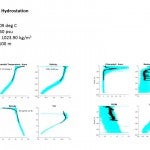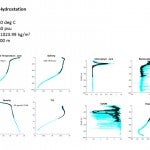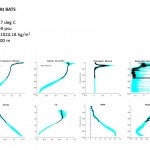All 3 gliders are back in the water (Figure 1). Anna has been profiling at Hydrostation S (HS) since Feb 20. Minnie (carrying a SUNA sensor) was redeployed at BATS on June 16 following a very successful 3-month Spring Bloom mission, and is again keeping station to extend those time series measurements into summer. Jack was recovered at BATS on June 16 and redeployed on June 28 at HS. For 2 days, Jack and Anna profiled in tandem to obtain cross-calibration of their sensors. For the next week, all three gliders will participate in a diurnal experiment: acquiring profiles to 500 m every hour to measure differences between daylight and nighttime conditions. A weak cyclonic eddy is approaching the BATS area from the east with southerly currents now occupying both sites.
As summer warms the ocean, SSTs at BATS and HS have increased to 26.17°C and 26.80°C, respectively. At both sites, deep chlorophyll maxima are found at 100 meters . Additionally, SSS is 36.60 psu at HS and 36.59 psu at BATS (Figures 2, 3, & 4 ).
Sea surface temperatures (SST) have been running higher since April compared to climatological values computed from the BATS, HS and Argo datasets (Figure 5). The minimum tropical storm SST (26ºC) is reached on average around day 190, while glider SSTs attained the 26ºC threshold closer to day 160 this year. The glider SSTs are about 1-2ºC higher than average providing a stronger than normal energy potential in the central Sargasso Sea as we enter Hurricane season.
This report was produced by Talia Rodkey, Lehigh Summer Intern for the MAGIC program.
- Figure 1
- Figure 2
- Figure 3
- Figure 4
- Figure 5






